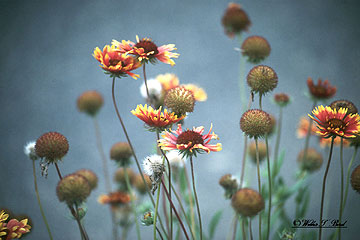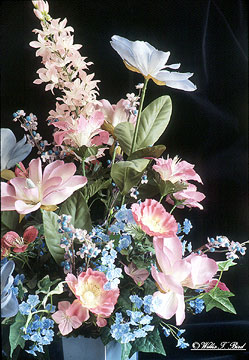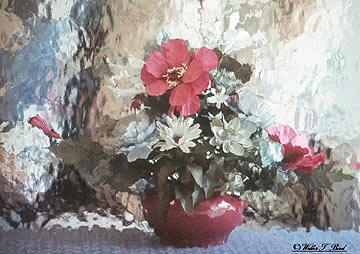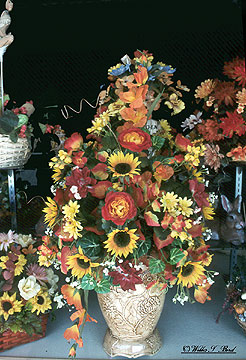 “Spring has sprung; the grass has riz; I wonder where my camera iz?” to para-rephrase an old poem of sorts. In spring and summer, flowers are everywhere and present perfect subjects for your camera. If you like color, blooms are for you. So bring your favorite film or digital camera, and let’s go take pictures.
“Spring has sprung; the grass has riz; I wonder where my camera iz?” to para-rephrase an old poem of sorts. In spring and summer, flowers are everywhere and present perfect subjects for your camera. If you like color, blooms are for you. So bring your favorite film or digital camera, and let’s go take pictures.
Flowers can wait for you as close as your mother’s garden or the dining room table. You can find them at a garden center by the thousands. Perhaps your town has a botanical garden or a local park decorated with flowers. Trees such as dogwoods or Bradford pear trees bloom. Your neighbors might love to have a shot of their favorite rose.
One nice aspect of flower photography is that your subject can’t run and hide from you like a squirrel or deer can. However, it isn’t all easy. Lighting and the movement caused by wind are always problems, but these can be managed. If you’re outside in the shade, you can use a flash or take along a white piece of poster board to reflect gentle light onto your subject. If the light is harsh and bright, consider using that same piece of poster board to create shade. It can also function to protect your flower from blowing all over the place by shielding it from mischievous breezes. If you have someone to help you or if you can build a contraption to hold the board in place, either would be a plus. Some clamps and an old tripod come in handy.
 Early morning is a good time for flower photos. The lighting is usually best, and wind generally isn’t much of a problem. Often you can find dewdrops on the petals, which is an enhancing effect for a flower shot. If you don’t find dew, there’s an old photographer’s trick that can stand-in for Mother Nature. Take a clean spray bottle (detergent or whatever) and fill it with water. Make sure it’s clean so the resulting spray won’t injure the flower or plant. If you use close-up attachments on your lens, you might capture a wonderful reflection of one of the droplets hanging from the plant’s stem, a thorn, or petals. I’ve seen a complete flower reflected within a droplet, which is spectacular. Trying to create one of these images takes a lot of work, patience, and luck.
Early morning is a good time for flower photos. The lighting is usually best, and wind generally isn’t much of a problem. Often you can find dewdrops on the petals, which is an enhancing effect for a flower shot. If you don’t find dew, there’s an old photographer’s trick that can stand-in for Mother Nature. Take a clean spray bottle (detergent or whatever) and fill it with water. Make sure it’s clean so the resulting spray won’t injure the flower or plant. If you use close-up attachments on your lens, you might capture a wonderful reflection of one of the droplets hanging from the plant’s stem, a thorn, or petals. I’ve seen a complete flower reflected within a droplet, which is spectacular. Trying to create one of these images takes a lot of work, patience, and luck.
I also like tabletop flower photography. Because I’m not adept with flash and artificial lighting, I move the table and flowers to a location near a window light source or even outside. Sliding glass doors are great for providing illumination. However, you have to work to make sure the lighting is even and not too one-sided. (I like to use natural lighting, but that’s a personal preference.) When you experiment with indoor tabletop photography, you don’t have to worry about breezes or stepping on other plants as you set up your shot. Bugs don’t bother you, either!
To add what I have termed “photocreationism” to some of my shots, I add textured glass in front of the flowers. This gives an abstract or painterly look to the photo. Being the frustrated painter that I am, I love to make a photo look like a painting. I’ve seen photo realistic paintings that look almost like photographs. Why not the other way around? I may even play photocreationist by working digitally in Photoshop.
 To become a photocreationist “in-camera,” I use an old piece of textured shower stall glass. Try to find one with a pleasing pattern and little or no color in the glass. It takes some practice to get everything set up right. You need to be sure of the light source and make sure it’s getting to the prop and not onto the glass causing glare or flare. The closer the object is to the glass from behind, the sharper the image. The further back from the glass the subject is, the blurrier the image becomes.
To become a photocreationist “in-camera,” I use an old piece of textured shower stall glass. Try to find one with a pleasing pattern and little or no color in the glass. It takes some practice to get everything set up right. You need to be sure of the light source and make sure it’s getting to the prop and not onto the glass causing glare or flare. The closer the object is to the glass from behind, the sharper the image. The further back from the glass the subject is, the blurrier the image becomes.
A manual 35mm camera works best for photocreationist shots. You don’t have to worry about auto focus focusing on the glass instead of the subject. You also have the preview button, so you can see what you’ll have when the shutter clicks. (This is somewhat difficult to do without the preview button, which many AF cameras no longer have.) The glass gimmick adds kick to a photo and will usually bring your viewers to life. They probably won’t have seen anything like it, so give it a try.
 When you shoot out in the field, try to get down and dirty with your flowers. Give yourself a rabbit’s eye view by getting on the ground with your subject. Shots in which the photographer shot up into the petals from beneath the flower are often good. Back lighting creates another good effect. You may wish to bracket your shots for a while until you become used to your camera and film using back lighting. That means you shoot three shots: one as the meter reads, one a stop below the reading, and one above the reading. Keep a record of which is which, so you can compare results afterwards. Fill-in flash (using your flash to fill in the dark areas) can keep shadows at bay.
When you shoot out in the field, try to get down and dirty with your flowers. Give yourself a rabbit’s eye view by getting on the ground with your subject. Shots in which the photographer shot up into the petals from beneath the flower are often good. Back lighting creates another good effect. You may wish to bracket your shots for a while until you become used to your camera and film using back lighting. That means you shoot three shots: one as the meter reads, one a stop below the reading, and one above the reading. Keep a record of which is which, so you can compare results afterwards. Fill-in flash (using your flash to fill in the dark areas) can keep shadows at bay.
Whether you’re shooting flowers in a vase, in a pot, or in the ground, your image can be a real winner if you’re careful and find unique views of the subject. Remember, for your photo to stand out, it should be different–not ordinary. Anyone can do the ordinary. Ask yourself, ”How can I make this image special?” Then do it! Just being around flowers can make a person happy. If you get the chance and if it’s okay with the owner, pick a few blooms for your mom or girlfriend. Or, pick some for yourself and feel good. Although you’ll have the real flowers to enjoy for only a few days, your photos can last a lifetime. Framed photos of flowers make great gifts. Most relatives and friends love them—especially when the photos were taken by YOU!
Note: If you have any ideas about photography projects you’d like to learn more about, please write your questions and ideas to Apogee and let them know. If it’s a subject I can help you with, I’ll be happy to oblige.
by Willis T. Bird

Leave a Reply